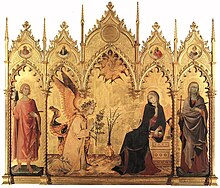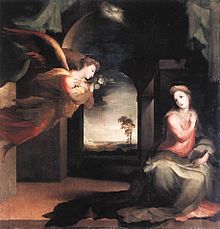
Back Müjdə xristian incəsənətində Azerbaijani Annunziata Finnish L'Annonciation French Annunciazione nell'arte Italian Anunciação na pintura Portuguese Благовіщення в християнському мистецтві Ukrainian



The Annunciation has been one of the most frequent subjects of Christian art.[1][2] Depictions of the Annunciation go back to early Christianity, with the Priscilla catacomb in Rome including the oldest known fresco of the Annunciation, dating to the 4th century.[3]
Scenes depicting the Annunciation represent the perpetual virginity of Mary via the announcement by the angel Gabriel that Mary would conceive a child to be born the son of God.
The scene is an invariable one in cycles of the Life of the Virgin, and often included as the initial scene in those of the Life of Christ. Frescos depicting this scene have appeared in Roman Catholic Marian churches for centuries, and it has been a topic addressed by many artists in multiple media, ranging from stained glass to mosaic, to relief, to sculpture to oil painting.[4]
- ^ The Oxford Companion to Christian Art and Architecture by Peter Murray and Linda Murray 1996 ISBN 0-19-866165-7 page 23
- ^ Images of the Mother of God: by Maria Vassilaki 2005 ISBN 0-7546-3603-8 pages 158–159
- ^ The Annunciation To Mary by Eugene LaVerdiere 2007 ISBN 1-56854-557-6 page 29
- ^ Annunciation Art, Phaidon Press, 2004, ISBN 0-7148-4447-0
© MMXXIII Rich X Search. We shall prevail. All rights reserved. Rich X Search